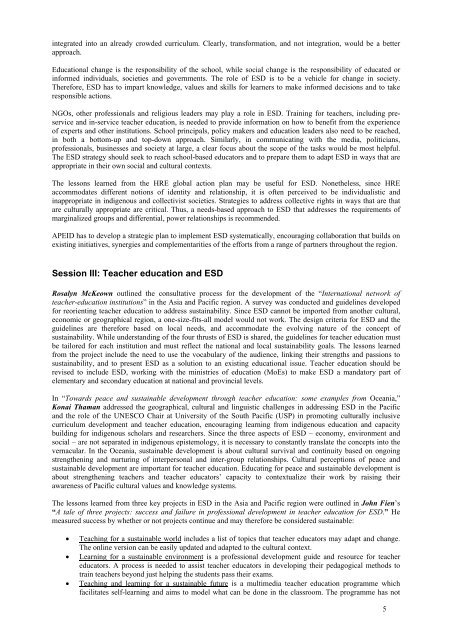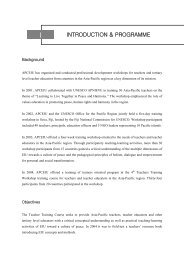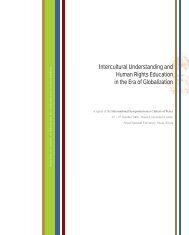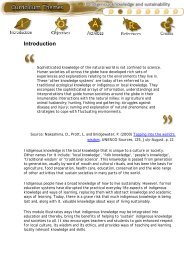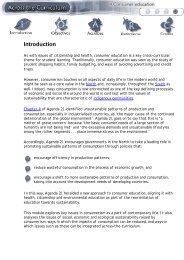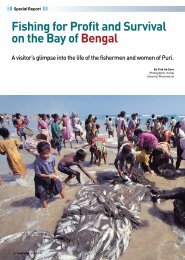REPORT OF UNESCO EXPERT MEETING ON - APCEIU
REPORT OF UNESCO EXPERT MEETING ON - APCEIU
REPORT OF UNESCO EXPERT MEETING ON - APCEIU
Create successful ePaper yourself
Turn your PDF publications into a flip-book with our unique Google optimized e-Paper software.
integrated into an already crowded curriculum. Clearly, transformation, and not integration, would be a better<br />
approach.<br />
Educational change is the responsibility of the school, while social change is the responsibility of educated or<br />
informed individuals, societies and governments. The role of ESD is to be a vehicle for change in society.<br />
Therefore, ESD has to impart knowledge, values and skills for learners to make informed decisions and to take<br />
responsible actions.<br />
NGOs, other professionals and religious leaders may play a role in ESD. Training for teachers, including preservice<br />
and in-service teacher education, is needed to provide information on how to benefit from the experience<br />
of experts and other institutions. School principals, policy makers and education leaders also need to be reached,<br />
in both a bottom-up and top-down approach. Similarly, in communicating with the media, politicians,<br />
professionals, businesses and society at large, a clear focus about the scope of the tasks would be most helpful.<br />
The ESD strategy should seek to reach school-based educators and to prepare them to adapt ESD in ways that are<br />
appropriate in their own social and cultural contexts.<br />
The lessons learned from the HRE global action plan may be useful for ESD. Nonetheless, since HRE<br />
accommodates different notions of identity and relationship, it is often perceived to be individualistic and<br />
inappropriate in indigenous and collectivist societies. Strategies to address collective rights in ways that are that<br />
are culturally appropriate are critical. Thus, a needs-based approach to ESD that addresses the requirements of<br />
marginalized groups and differential, power relationships is recommended.<br />
APEID has to develop a strategic plan to implement ESD systematically, encouraging collaboration that builds on<br />
existing initiatives, synergies and complementarities of the efforts from a range of partners throughout the region.<br />
Session III: Teacher education and ESD<br />
Rosalyn McKeown outlined the consultative process for the development of the “International network of<br />
teacher-education institutions” in the Asia and Pacific region. A survey was conducted and guidelines developed<br />
for reorienting teacher education to address sustainability. Since ESD cannot be imported from another cultural,<br />
economic or geographical region, a one-size-fits-all model would not work. The design criteria for ESD and the<br />
guidelines are therefore based on local needs, and accommodate the evolving nature of the concept of<br />
sustainability. While understanding of the four thrusts of ESD is shared, the guidelines for teacher education must<br />
be tailored for each institution and must reflect the national and local sustainability goals. The lessons learned<br />
from the project include the need to use the vocabulary of the audience, linking their strengths and passions to<br />
sustainability, and to present ESD as a solution to an existing educational issue. Teacher education should be<br />
revised to include ESD, working with the ministries of education (MoEs) to make ESD a mandatory part of<br />
elementary and secondary education at national and provincial levels.<br />
In “Towards peace and sustainable development through teacher education: some examples from Oceania,”<br />
Konai Thaman addressed the geographical, cultural and linguistic challenges in addressing ESD in the Pacific<br />
and the role of the <strong>UNESCO</strong> Chair at University of the South Pacific (USP) in promoting culturally inclusive<br />
curriculum development and teacher education, encouraging learning from indigenous education and capacity<br />
building for indigenous scholars and researchers. Since the three aspects of ESD – economy, environment and<br />
social – are not separated in indigenous epistemology, it is necessary to constantly translate the concepts into the<br />
vernacular. In the Oceania, sustainable development is about cultural survival and continuity based on ongoing<br />
strengthening and nurturing of interpersonal and inter-group relationships. Cultural perceptions of peace and<br />
sustainable development are important for teacher education. Educating for peace and sustainable development is<br />
about strengthening teachers and teacher educators’ capacity to contextualize their work by raising their<br />
awareness of Pacific cultural values and knowledge systems.<br />
The lessons learned from three key projects in ESD in the Asia and Pacific region were outlined in John Fien’s<br />
“A tale of three projects: success and failure in professional development in teacher education for ESD.” He<br />
measured success by whether or not projects continue and may therefore be considered sustainable:<br />
• Teaching for a sustainable world includes a list of topics that teacher educators may adapt and change.<br />
The online version can be easily updated and adapted to the cultural context.<br />
• Learning for a sustainable environment is a professional development guide and resource for teacher<br />
educators. A process is needed to assist teacher educators in developing their pedagogical methods to<br />
train teachers beyond just helping the students pass their exams.<br />
• Teaching and learning for a sustainable future is a multimedia teacher education programme which<br />
facilitates self-learning and aims to model what can be done in the classroom. The programme has not<br />
5


